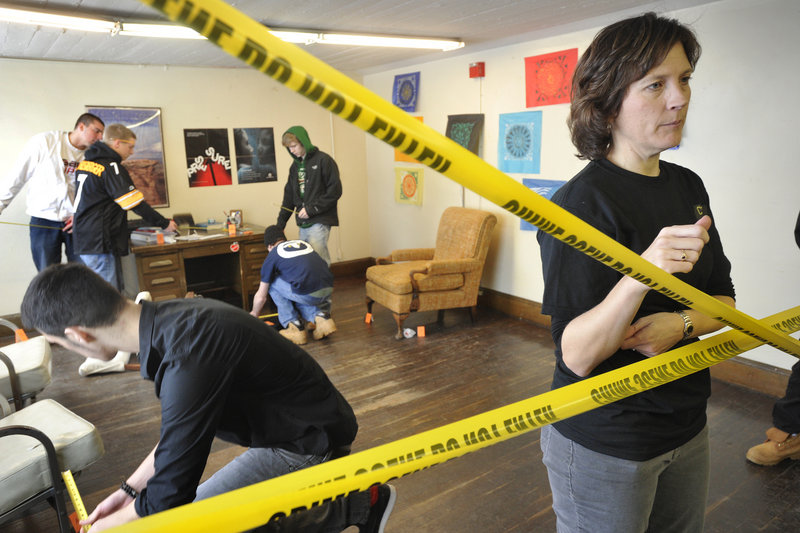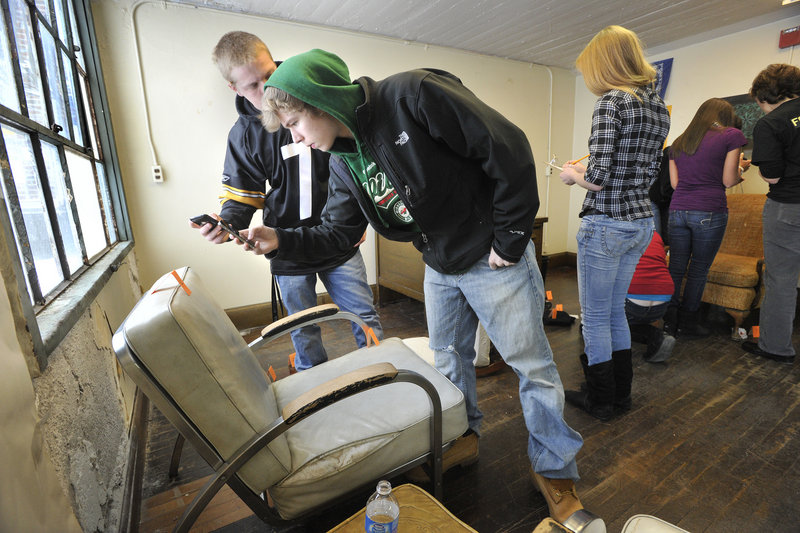PORTLAND — One could almost hear the heart-thumping strains of The Who as students filed into the mock crime scene on the fourth floor of Deering High School on Tuesday.
Details of the case could have been “ripped from the headlines” or featured in the latest episode of “CSI.”
It was the first day of the final investigation for Karen Shibles’ forensic science classes, one of the newest and most popular courses at the high school.
The body of a newly hired (and nonexistent) substance abuse counselor had been found in her office just before school started. Her death had been ruled suspicious, Shibles told her students. Police were interviewing several suspects, all of them faculty members.
Behind the yellow crime-scene tape, students set about taking measurements and photographs, sketching the room and cataloging evidence.
“It definitely feels like a crime scene,” said Jamie Ross, a senior, wielding a measuring tape. “I think it’s amazing, the way you can use equations to put together something that the naked eye would never see.”
That’s the response Shibles hoped to elicit when she set out to develop Deering’s forensic science program three years ago. A biology teacher, Shibles was a fan of the “Law & Order” and “CSI” television series, and so were many of her friends and students.
“I figured, there’s got to be a way to bring that excitement into the classroom and pull it all together with science,” Shibles said.
At the very least, Shibles wanted to incorporate forensics into her biology classes. Her real goal was to develop a separate forensic science elective that would incorporate various aspects of biology, chemistry and physics.
She took a two-week forensics course at The College of the Atlantic in Bar Harbor, then followed it with a four-day workshop offered by the publisher of a high school forensic science textbook.
The rise of DNA evidence and other forensics in high-profile court cases and on popular television shows is driving a growing interest in high school forensic programs nationwide, Shibles said. Morse High School in Bath and Mount Ararat High School in Topsham offer similar courses, she said.
Shibles pitched the new program and got the go-ahead to start offering forensics in the fall of 2009. She used some of her own money to buy supplies and received a $300 grant from the Portland Education Foundation.
She taught two sections of forensics in each semester of the first year. This year, she taught three sections during the fall semester, which ends this month, and will teach two sections during the spring semester. Each section has about 20 students.
“We had a good first year and it just took off,” Shibles said. “It’s exciting for me, too, because I’m trying to master the material right along with them. I think it’s important for kids to see (teachers) as learners, too.”
David Galin, chief academic officer of Portland public schools, praised Shibles’ initiative in developing the forensics course and her ability to generate excitement about real-life science.
“It’s what we would like all of our students to experience,” Galin said. “When the teacher demonstrates a real love for the subject, that’s when we get real learning.”
The course is open to juniors and seniors of all ability levels. It attracts students who love science or see a future in forensics or criminal justice, and others who just think the subject is cool.
Jamie Ross said he took the class because he has always been interested in forensics. His father, Ted, is a Portland police captain and he may follow in his footsteps, he said.
Katie Langford said she took the class because she loves “Law & Order: SVU” and she thought forensics was the most interesting of all the science courses offered at Deering.
Shibles leads her students through investigations, tagging key items and evidence at mock crime scenes and providing background information about victims and suspects.
In this week’s three-day final investigation, the blood and hair are fake, but the fibers and fingerprints are real. “Bloody” scissors found at the scene seem significant. The DNA report and autopsy may prove otherwise.
Today and Thursday, students must analyze evidence and suspects’ stories, develop theories and time lines, and write final essays re-creating the crime.
“Everything counts up there, so pay attention,” Shibles told her students on their way up to the fourth-floor loft. “We need to find out what actually went down.”
Staff Writer Kelley Bouchard can be contacted at 791-6328 or at: kbouchard@pressherald.com
Send questions/comments to the editors.




Success. Please wait for the page to reload. If the page does not reload within 5 seconds, please refresh the page.
Enter your email and password to access comments.
Hi, to comment on stories you must . This profile is in addition to your subscription and website login.
Already have a commenting profile? .
Invalid username/password.
Please check your email to confirm and complete your registration.
Only subscribers are eligible to post comments. Please subscribe or login first for digital access. Here’s why.
Use the form below to reset your password. When you've submitted your account email, we will send an email with a reset code.